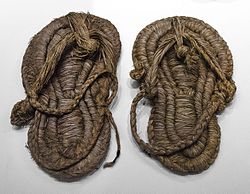|
Esparto Esparto, halfah grass, or esparto grass is a fiber produced from two species of perennial grasses of north Africa, Spain and Portugal. It is used for crafts, such as cords, basketry, and espadrilles. Stipa tenacissima and Lygeum spartum are the species used to produce esparto. Stipa tenacissima (Macrochloa tenacissima) produces the better and stronger esparto. It is endemic to the Mediterranean region (growing in Portugal, Spain, Morocco, Algeria, Tunisia, Libya and Egypt). Another name in Spanish for the plant is "atocha," a pre-Roman word. "Esparto" or σπάρτο in Greek may refer to any woven products of sedge or broom, including cords and ropes.[1] This species grows forming a steppic landscape – esparto grasslands – which covers large parts of Spain and Algeria. History Esparto leaves have been used for millennia. The oldest baskets of esparto, dating back 7,000 years, were found in a cave in southern Spain (Cueva de los Murciélagos, Albuñol, Granada). This collection is now in the National Archaeological Museum of Spain. There are many esparto remains in archaeological settlements from as long ago as the Neolithic period, including rugs, ropes, clothes, etc. Iberians used esparto rugs as floor coverings. For Greeks, Phoenicians and Romans, esparto was the best raw material for boat ropes. For centuries, esparto grasslands have been managed by local populations in order to boost the harvest, due to its economic value. In southern Spain there is an "Esparto culture": a deep knowledge about the many uses of this fiber forms part of the traditions of these communities. After the Spanish Civil War (1936–1939), esparto was declared a "national fiber"; there was even a National Esparto Service. The opening of markets to other fibers and plastics eventually led to the decline of the esparto industry.  ApplicationEsparto leaves are traditionally harvested with a stick; usually of wood or iron, but in ancient times, of bone. The stick is used to pull up a handful of leaves at a time. The esparto is not normally used immediately after harvesting. Instead, the leaves are left to dry in the sun until they turn yellowish. This is the raw esparto, which is used for different basketry techniques. An alternative is to soak the leaves in water for about a month, before drying and then crushing them. This material is known as "crushed esparto", which is stronger and easier to weave. The main techniques are:
All techniques involve working with an odd number of strands, from 5 to 31 or more.
There are many complementary techniques to end the baskets, square braids, cord edging, crown sinnet, points, etc. In the finest pieces, all leaves used must be the same size and diameter, and must always be joined in parallel. Traditionally, esparto basketry has not been a professional product. Shepherds, farmers and other people of the countryside used to plait esparto on rainy days or in times not suitable for working. Most craft tools and artifacts in the southern Spanish countryside for farming and livestock were made with esparto, such as harvesting baskets, items for the home, and containers/sacks for carts, horses, and donkeys. There is a huge variety of items, many of which are well known and have a specific use, but others are the product of a special personal need or a free creation, such as toys for children or animals. Every kind of basket has a special name that describes its use. For example, a "cesto rosero" is a basket used traditionally to gather saffron flowers. A special esparto basketry piece is the esparto canteen. Made with crushed esparto and waterproofed with pine pitch, they were used by the shepherds of southeastern Spain to carry water in the mountains. The Archaeological Museum of Cartagena has an example of a Roman esparto canteen two thousand years old. Esparto was also used for making slingshots. In ancient times these were used as weapons of war, but could also be used for hunting or by shepherds to protect their livestock. A wide strip of plaited raw esparto, named "pleita" in Spanish, is the traditional mold for Manchego cheese. Another important use of esparto is in rope-making. Ropes could be made with raw esparto, crushed esparto or raked esparto (after crushed). A special rope was used to tie cereal bunches in harvest time. Other were used in vernacular architecture to tie reeds to the timber in roof building.[3] PaperEsparto grass is known for its use in papermaking. The fiber makes a high quality paper often used in book manufacturing. First used in Great Britain in 1850 by Thomas Routledge[4] who imported it from southern Spain, and it was greatly exploited by Edward Lloyd at his paper mills at Bow-Bridge[5] and Sittingbourne from the 1860s. Lloyd imported his raw materials from Oran and Arzew in Algeria. It has been extensively used in the UK and Europe, but due to transportation costs, it is rarely found in the United States. Most paper made from esparto is usually combined with 5% to 10% wood pulp. The fibers are fairly short in relation to their width, yet do not create any significant amount of dust. Because of the short fiber length, the tensile strength of the paper is less than that of many other papers, but its resistance to shrinkage and stretching is superior, and the paper is a well-filled, dense paper with excellent inking qualities. It also has very good folding properties. Some manufacturers of rolling paper may use esparto, which might lead to a slightly higher carcinogen level when burned.[6] Other usesThe old leaves, which are under the plant, were used to make the traditional torches of southern Spain, named "hachos". They are also used by beekeepers to produce smoke while taking honey from the hives. Shepherds would sometimes weave a makeshift spoon from esparto leaves to eat curdle. Gallery
References
Sources
External links
|
Portal di Ensiklopedia Dunia









